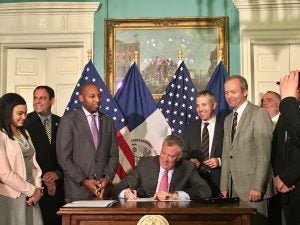 The New York City Council has an excellent environmental track record, and I’m pleased to say that most recently it has passed a group of bills tackling energy efficiency in buildings, adding to its stellar standing.
The New York City Council has an excellent environmental track record, and I’m pleased to say that most recently it has passed a group of bills tackling energy efficiency in buildings, adding to its stellar standing.
Mayor Bill de Blasio signed a package of laws developed by the City Council that address energy efficiency in thousands of buildings citywide. Buildings account for nearly three-quarters of the city’s greenhouse gas emissions, which makes buildings crucial to New York City’s goal of reducing emissions 80 percent by 2050. In fact, the mayor’s office estimates that these bills will reduce greenhouse gas emissions by roughly 250,000 metric tons throughout the city, and create an estimated 100 jobs by spurring retrofits in 16,000 buildings. I attended the bill signing on October 31st, and am proud to say that Environmental Defense Fund (EDF) has been working closely with both the mayor’s office and the City Council to get to this point, along with our partners, the New York League of Conservation Voters, Natural Resources Defense Council, and Urban Green Council.
These new laws – which affect 57 percent of New York City’s buildings (a higher percentage than any other U.S. city) – are important because they mandate that buildings track their energy use. Tracking use will inform necessary energy-efficiency upgrades that will have lasting impacts and ultimately improve the city’s environment and New Yorkers’ public health.
Here’s a quick overview of the bills:
- Intro 1163-A expands an earlier requirement so that buildings of at least 25,000 square feet will also benchmark their energy use. Benchmarking allows buildings to collect information on energy performance that shows how they use power compared to other buildings in their category.
- Intro 1160 will mandate sub-meters that will track electricity for businesses in rented spaces larger than 5,000 square feet. Sub-meters give renters data about their energy use so they can manage it.
- Intro 1165, an amendment to Local Law 88, mandates lighting upgrades by the year 2025 to buildings larger than 25,000 square feet. With technological improvements happening as quickly as they do, required upgrades will ensure building lighting efficiency keeps pace.
Electricity-use information is essential. The more buildings understand their overall energy use, the more they can take steps to make efficiency improvements to save energy.
Where do we go from here?
New York City is making potential energy savings more tangible by increasing the number of buildings required to monitor energy use. But, benchmarking and identifying a building’s energy efficiency needs are only the first step.
Programs like the NYC Retrofit Accelerator step-in and give buildings tools that actually help make necessary energy efficiency upgrades, so they can save on energy and costs.
We’ve made progress already. Between 2010 and 2013 alone, citywide emissions decreased by 8 percent, and building energy use decreased by 6 percent. But there is still more work to be done. By working closely with the New York City Council, the Mayor’s Office of Sustainability, and other city agencies, EDF will help ensure New York builds on this progress. Stay tuned, and you’ll see it happen.
Enviroshop is maintained by dedicated NetSys Interactive Inc. owners & employees who generously contribute their time to maintenance & editing, web design, custom programming, & website hosting for Enviroshop.
